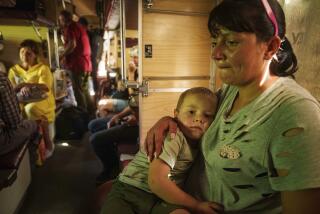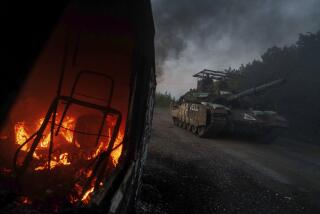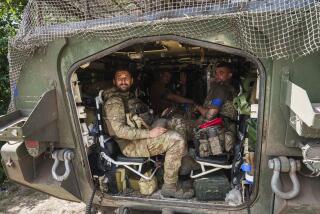Yugoslav Tank Force Advances Toward Slovenia
LJUBLJANA, Slovenia — The Yugoslav federal army under the command of renegade generals deployed a massive invasion force Wednesday, sending 180 tanks and armored vehicles thundering into neighboring republics and threatening a clash with Slovenia that could inflict thousands of casualties.
The army advance from Belgrade triggered a full-scale alert and defensive deployments in the republics of Croatia and Slovenia, which declared independence from Yugoslavia on June 25.
However, the massive advance halted before reaching Slovenia and was not known to have engaged any other republic’s forces.
While the army movement instilled widespread fear, there was little armed conflict in Slovenia on Wednesday, and one senior military figure claimed that the army was holding its fire.
The Yugoslav People’s Army has declared itself at war with Slovenia, a move that appeared tantamount to a military coup. The power to command the armed forces rests with the federal president, whose calls for a withdrawal have been ignored.
There was no clear sign, even 24 hours after the ominous declaration, that the federal prime minister or defense minister had any influence with the hard-line Serbian Communists directing the military offensive against Slovenia.
Thousands of troops--described as loyalists and reportedly drawn exclusively from the Communist republics of Serbia and Montenegro--rumbled in the armored column into neighboring Croatia and Bosnia-Herzegovina on Wednesday after an arch-conservative Communist general threatened to fight Slovenes “to the end.”
The army chief of staff, Gen. Blagoje Adzic, vowed to crush Slovenian secessionists only hours before the huge armored column began its advance.
Slovenian President Milan Kucan had said the previous evening that Slovenia’s determined defense forces would observe a unilateral cease-fire until Wednesday afternoon as long as the federal army did not attack them.
Gen. Andrija Raseta, deputy commander of federal troops in Slovenia, claimed that the soldiers dispatched from Belgrade had been ordered not to take the offensive.
Raseta denied that the army was acting outside government control. He said the 180,000-member military recognized the authority of the new chairman of the collective federal presidency, Stipe Mesic, a Croat whom the dominant Serbian republic has accused of seeking the destruction of Yugoslavia.
While his statement held out some hope that the army would back off, it more likely indicates a division of thinking between conservatives and moderates within the command structure.
Slovenian Information Minister Jelko Kacin dismissed Gen. Raseta’s statement as a ploy and said 40,000 Slovenes had moved to new defensive positions.
Kacin said he had learned that the federal troops were ordered to attack today.
Western efforts to reach a negotiated solution to the Yugoslav crisis continued, although hopes were fading for a breakthrough that would stave off a devastating battle that could leave thousands of dead and wounded.
Ciril Zlobec, a member of Slovenia’s ruling council, said European Community diplomats had urged the republic “not to do anything that would legitimize massive army intervention.”
The EC delegation, which is visiting Yugoslavia, said it would push for the U.N. Security Council to take up the situation in Yugoslavia in the event of further hostilities or overt signs of a military coup.
Aside from scattered gunfire and aerial surveillance flights, no combat between the army and Slovenian reservists was reported Wednesday.
During the respite from fighting, army helicopters marked with Red Cross insignia were allowed to deliver supplies to bases that have been surrounded by Slovenian forces. They also evacuated wounded soldiers from Slovenian hospitals.
The reprieve was not expected to last long, considering the deployment of the massive invasion force.
One large armored column rolled out of a Belgrade-area garrison early Wednesday morning and headed along the highway to Zagreb, the Croatian capital. Belgrade television showed hundreds of Serbs gathered along the roadside, cheering on the federal advance.
Tank columns also moved into eastern Croatia and the ethnically mixed republic of Bosnia-Herzegovina, according to Croatian Radio. Both republics have been the scene of recent clashes between Serbs and other ethnic groups, and the federal troops’ movement into those trouble spots triggered fears of renewed violence.
The Croatian government placed its police and reservists on high alert.
Croatia’s nationalist leadership has insisted that federal forces already deployed in Croatia must return to their bases. Croatia has also threatened to disarm illegal Serbian militia units with which Croats have repeatedly tangled. About 40 people have died in ethnic violence in Croatia since May.
The International Red Cross has appealed to both sides to respect agreements guaranteeing humanitarian treatment of prisoners and casualties.
Some federal soldiers have spent a week cooped up inside their armored vehicles during standoffs with Slovenian guerrillas. There have also been cases of wounded troops being trapped in their damaged tanks for hours, with emergency aid vehicles unable to reach them because of the barricades sealing off areas of conflict.
More to Read
Sign up for Essential California
The most important California stories and recommendations in your inbox every morning.
You may occasionally receive promotional content from the Los Angeles Times.











